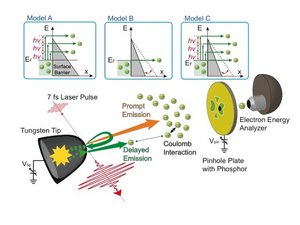Our group studies the creation of ultrafast flashes of light (the source side) and the interaction of this ultrafast light with matter (the detector side) using a variety of numerical and analytic methods, ranging from quantum trajectory methods and other semi-classical approaches to techniques from nonlinear dynamical systems to methods that focus on single photon ionization of many-electron systems, such as relativistic random phase approximation. Below are some topics of interest.
Capturing attosecond electron dynamics in atoms, molecules and condensed matter systems
The key experimental tools in ultrafast science are ultrafast optical and IR pulses (few cycle pulses in the range of visible light, corresponding to about 400-800 nm) and attosecond pulses in the XUV range of the spectrum (corresponding to 10-100 nm wavelength). These two types of pulses interact very differently with matter, since XUV photon energy is close to ionisation potential of valence shell electrons (leading to single photon ionisation), while optical and IR pulses ionize either via tunnel or multi-photon ionisation. We study how these different types of laser pulses can be used to excite and control matter.
TUNNEL IONIZATION IN ATOMS AND MOLECULES
A fundamental process in ultrafast science is tunnel ionization, whereby a strong laser field bends the binding potential of the atom or molecule so that the bound electron tunnels out and is subsequently accelerated in the strong laser field. This process also underlies the creation of high frequency (in the XUV range) attosecond pulses via the process known as High Harmonic Generation (HHG). We investigate how experimental observables, such as momenta of electrons observed at the detector or HHG spectra, can be used to reconstruct electron dynamics before and after ionization in real time.

Electron momenta distributions after ionization of an N2 molecule with a strong ultrafast laser pulse. The results are obtained using Quantum Trajectory Monte Carlo (QTMC) simulations and can be directly compared with experimental data (for more information, see Ortmann et al, Physical Review Letters 127, 213201, 2021)
PROBING ATOMS AND MOLECULES WITH ATTOSECOND PULSES
Many state-of-the-art experiments employ a pump-probe scheme, combining relatively weak attosecond pulses to excite the dynamics (pump), which are subsequently probed with an IR pulse. This pump-probe scheme can be used to study electronic and vibrational properties of atoms and molecules, such as in quantum beat spectroscopy, or probe the delays in single photon ionisation. Much theoretical analysis relies on the solution of the time dependent Schrodinger equation (TDSE), which however is possible only in simple atoms or highly symmetric molecules. Our group is developing classical and semi-classical methods to accurately describe ionisation of atoms and molecules using attosecond pulses. Such methods are much less computationally expensive than TDSE and can be used to accurately treat multi-electron dynamics in more complex systems, such as organic molecules.

RABBIT trace for orientation-resolved ionization of a CO molecule. From the difference between the ionization time from the oxygen-side and the carbon-side, it is possible to experimentally measure the stereo-Wigner time delay. The Classical Wigner Propagation (CWP) method developed in our group was then used to localize an electron immediately after ionization and thereby fully reconstruct Einstein’s photoelectric effect (taken from Vos et al, Science 360, 2018)
X-RAY ATTOSECOND PULSES
Coherent high intensity x-ray sources of radiation are now becoming available with X-ray Free Electron Lasers (XFELs), as well as more compact devices using HHG with mid-IR driving sources, or laser-plasma interaction. While traditionally available XUV sources have frequencies that corresponds to ionization potential of valence electrons, x-rays ionize core states in atoms and molecules. X-ray sources can therefore be used to study inner shell dynamics and electron re-arrangement following removal of an electron, including processes like Auger decay. We are interested in correlated electron dynamics following single photon ionization of inner-core electrons with an attosecond high frequency pulse, such as the ones produced at LCLS.

Streaking experiment based on the attoclock technique to time ionization with high frequency X-ray attosecond pulses produced by XFEL at LCLS (taken from Li et al, Science 375, 2022).
ATTOSECOND PHYSICS AT THE NANOSCALE
Electron tunnelling emission from a nanostructure due to strong DC fields has been widely used in modern science and technology because it produces bright and coherent electron beams. AC fields of an ultrashort laser pulse can produce ultrashort coherent sources of electron beams, if the dominant ionization mechanism is via tunnel (as opposed to multi-photon) emission. We are developing analytical and numerical methods to understand interaction of nano-structures with ultrafast laser pulses. Of particular interest is finding the correct ionisation model (see Panels A-C in figure above) and understanding better the rescattering mechanism. This is a relatively new field where common analytic tools of strong field physics (such as the dipole approximation) break-down and new behaviour emerges.

Interaction of a tungsten nano-tip with an ultrafast laser pulse, including different emission mechanisms. Model A: multi-photon; Model B: tunneling; Model C: mixture of tunneling and multi-photon (taken from Yanagisawa et al, Scientific Reports 6, 2016).
HIGH HARMONIC GENERATION IN CONDENSED MATTER
The interaction of ultrashort laser pulses with condensed matter systems provides a unique perspective of strong field phenomena, such as tunnel ionization or high harmonic generation (HHG), which until recently have only been investigated in atomic gas. We are interested in how HHG can be used to probe correlated electron dynamics (such as dublon production in Mott insulators), reconstruct Berry curvature, investigate topological phase transitions, or extract high-order nonlinear susceptibility of materials (see figure below). We are currently working on ultrafast electron dynamics at metal/magnetic insulator interface, as part of a larger collaboration within IRG-1 and the Center for Emergent Materials (CEM) at OSU: https://cem.osu.edu/research/irg-1-metal-magnetic-insulator-interfaces/